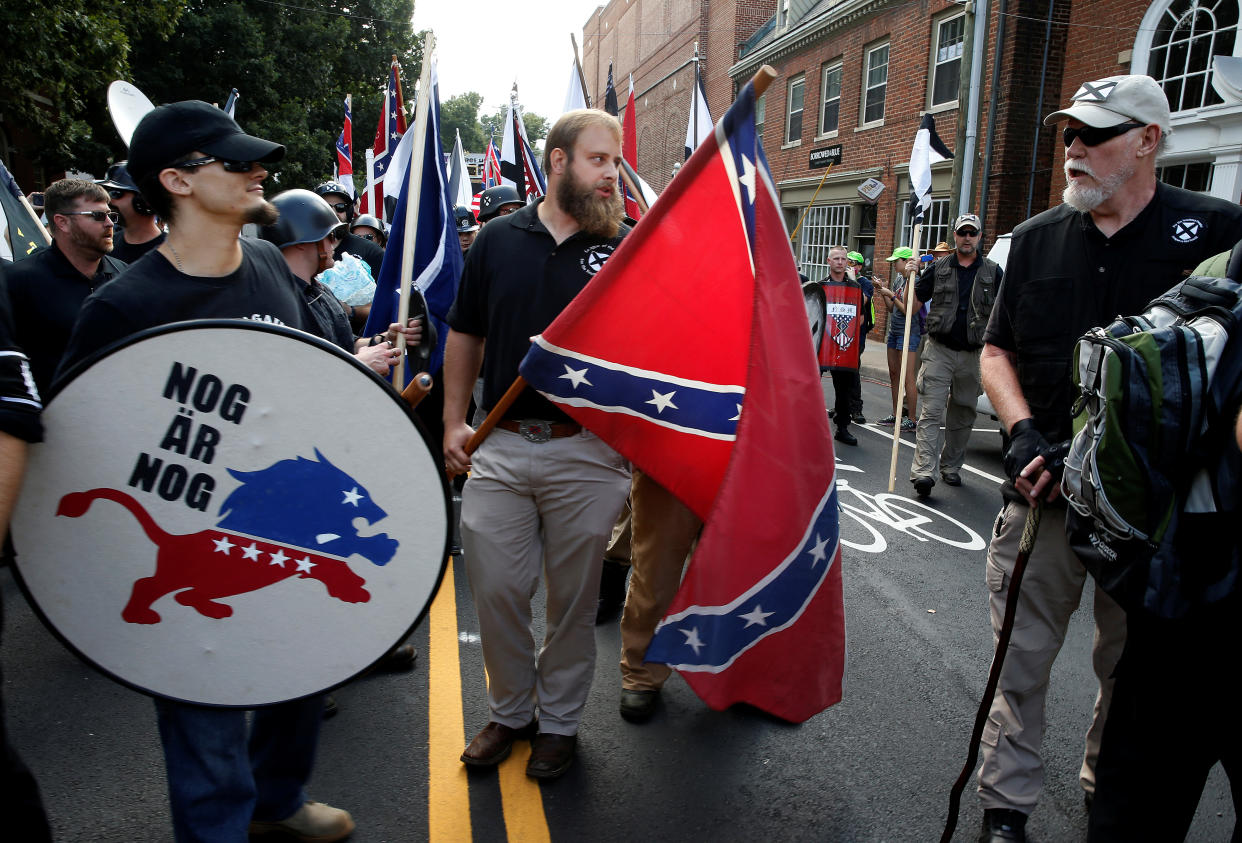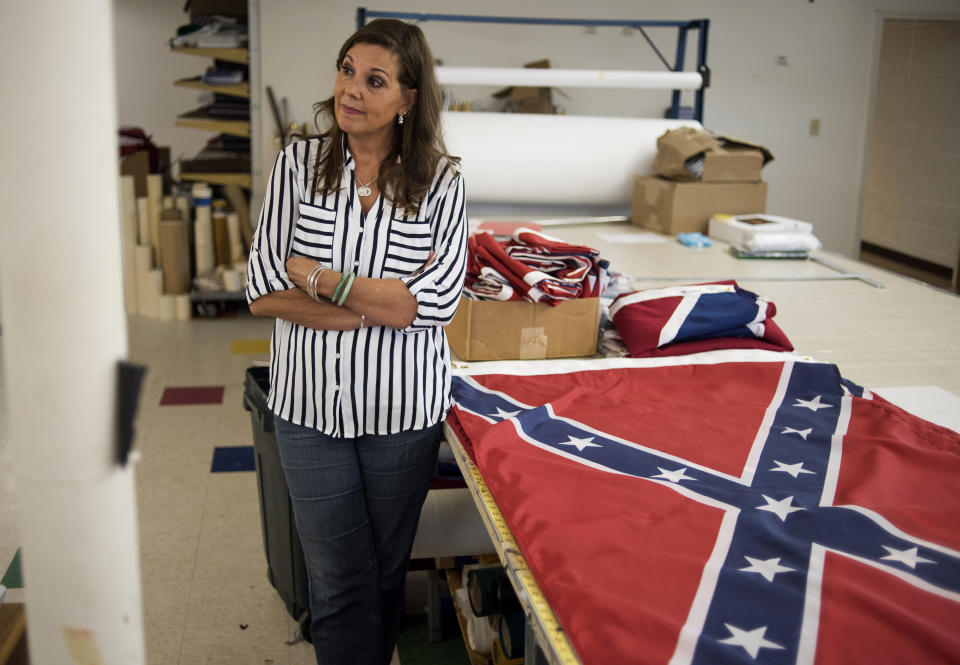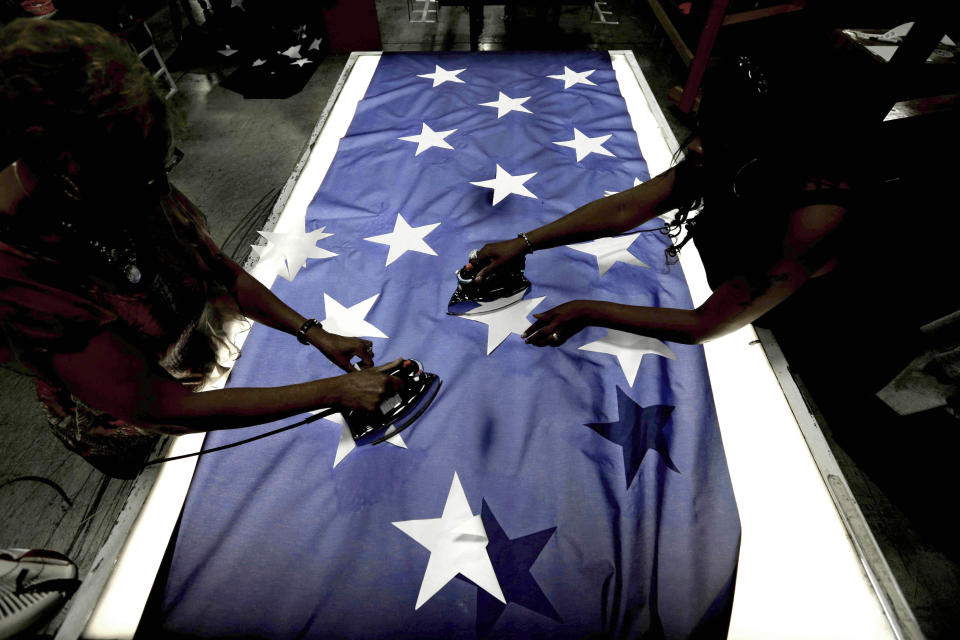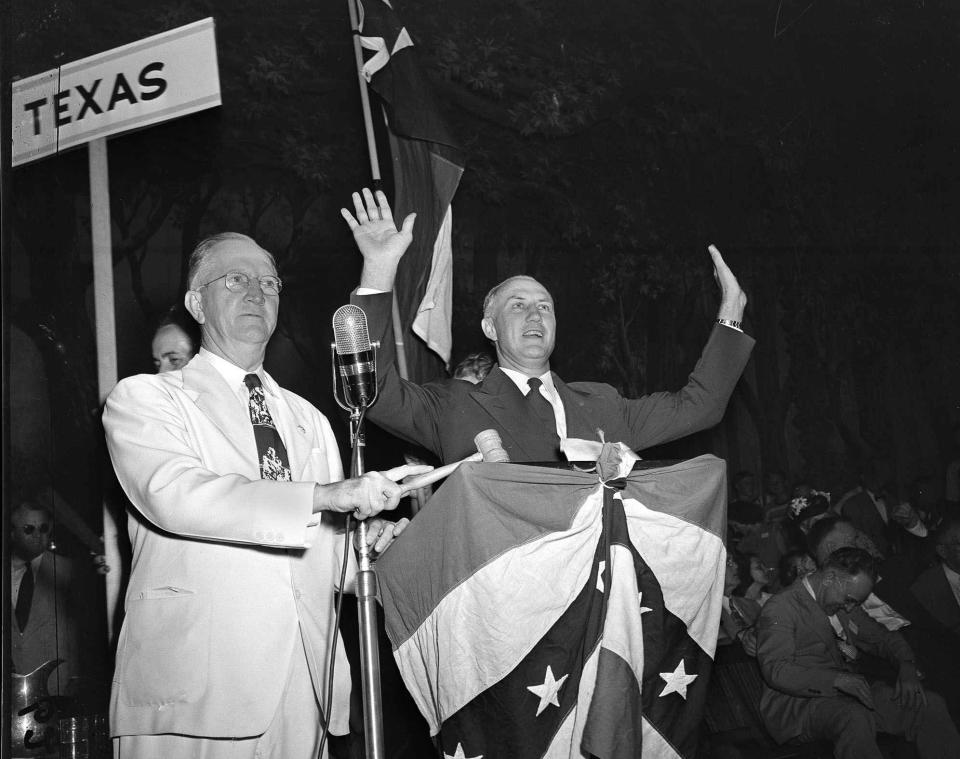How the Charleston massacre changed the Confederate flag market

Belinda Kennedy’s Alabama Flag and Banner, founded in 1985, had always sold Confederate battle flags. The company had marketed stock that it bought from manufacturers, but it had never been a huge income generator. Custom flags, especially oversize U.S. flags, table covers and banners were more important to the small company’s bottom line.
“In a typical year, I would say, we’d sell maybe in the hundreds [of Confederate flags] — not that many,” she recalled in an interview with Yahoo News. “That was before the shooting in the church.”
By “the shooting,” Kennedy meant the June 2015 day when white supremacist Dylann Roof gunned down nine African-Americans after joining their Bible study at a historically black church in Charleston, S.C. A photograph of Roof clutching a black handgun and holding a small Confederate battle flag fueled a backlash against symbols of the secessionist South. But the backlash also triggered a bonanza for flag sellers like Kennedy.

The anti-Confederate movement gained new strength this week after neo-Nazi and white supremacist demonstrators, some waving the Confederate battle flag, staged a rally in Charlottesville, Va. One white nationalist allegedly drove his car deliberately into a crowd of peaceful protesters, killing Heather Heyer, 32.
After the violent Charlottesville clashes, cities across the country have started reassessing their monuments to the Confederacy, which formed to protect and maintain the U.S. institution of slavery. Several cities have already opted to remove their Confederate statues.
The Charleston massacre sparked a similar wave of change in the Confederate flag industry. After the mass shooting, major retailers — Amazon, eBay, Sears, WalMart — said they’d stop selling the rebel flag. In the America of 2017, you can’t buy Confederate battle flag bikinis on Amazon, though you can listen to songs about the women who wear them via the company’s streaming service.

The online auction site eBay, which connects individual buyers and sellers, uses a range of tools to keep out the Confederate flag.
“We take proactive measures to identify listings that violate our policies, including but not limited to, keyword filters and automated monitoring tools,” an executive with the company told Yahoo News. “Additionally, every listing has a ‘Report This Item’ link, allowing our community members to alert us to listings for our review and removal.”
But “it’s challenging,” explained the executive, who spoke on condition of anonymity. Some sellers don’t know about the ban. Others take steps to try to circumvent it — on the day Yahoo News spoke to the eBay official, someone was trying to sell a Confederate flag but had put it up in the “Books” category in an apparent attempt to skirt the restrictions.

The National Park Service joined in, announcing that its gift shops would no longer carry “stand-alone” items that only featured the flag. At the Gettysburg gift shop, this meant pulling just 11 out of 2,600 items sold at the Civil War battle site.
The country’s oldest and largest flag manufacturers also enlisted, opting to stop making the banner.
Annin Flagmakers was founded in 1847 and supplied Union forces with the U.S. flag during the Civil War, according to Mary Repke, the company’s senior vice president of sales and marketing. But until the Charleston shooting, it also had sold some Confederate battle flags, “mostly to Civil War reenactors,” she told Yahoo News.
“It made up, like, 0.00001 percent of our total volume,” Repke said. Annin today sells at least 10 million U.S. flags per year, and 20 million flags total when you add international, military, religious and other banners. But no Confederate battle flags, with the exception of those included in state flags.
“Flags are very powerful symbols, and clearly this flag has become a symbol of a negative aspect of our country’s past,” Repke said. “For some people, it represents something very negative and hateful.”
Dropping the flag was also an easy call for Valley Forge Flag, which had never sold that many anyway, according to Reggie VandenBosch, its vice president of sales.
“It was a fraction of a percent [of revenues]. It was even, like, not even one-tenth of 1 percent,” he told Yahoo News.
Repke and Vandenbosch both told Yahoo News that Chinese flagmakers have largely filled the vacuum.
They’re relatively easy to find via the online retail giant Alibaba, though consumers have to know to search for “Confedrate flag,” not the correctly spelled “Confederate flag,” which turned up no results at the time this story went live.

But most U.S.-based companies that hawk flags online aren’t manufacturing them.
“After U.S.-based manufacturers stopped making them, most of the public, the general public, would buy from [online] sites,” said Repke. “That’s not a domestic flag; that’s usually an import from China or someplace. Mostly China.”
That raises the possibility that some of the self-described nationalists in Charlottesville may have been waving a Confederate flag made in Shanghai.
“With the U.S. flag, the consumer is very concerned that it be made in the United States, understandably,” said VandenBosch. “But with the Confederate flag, the priority for most is to find it as inexpensively as possible.”
That hasn’t deterred some producers. An online search turned up a handful of independent seamstresses who appear to run their businesses out of their homes. One, in South Carolina, sells a 36- by 54-inch battle flag for $325 on her “Dixie Memories” site, where visitors are met with a brass band version of “Dixie,” essentially the South’s anthem.

“I dedicate my work to heroes of all races, including African-Americans, Asians and Hispanic, who wore the gray,” she says on the main page. “We have only love for others whose skin color is different from our own.” (Historians have largely dismissed revisionist accounts claiming that there were significant numbers of nonwhite Confederate soldiers.)
Efforts to reach the Dixie Memories flagmaker were unsuccessful.
But for Kennedy of Alabama Flag and Banner, cheap Chinese flags are part of the problem. “I don’t want to sell a $4 flag,” she said. “Theirs is a lower-quality flag.”
The decision to start producing Confederate battle flags in-house, with a staff of just a dozen seamstresses, came shortly after Roof’s rampage.
“What happened to us was, when Wal-Mart and Amazon took everything with a flag off the shelves, suddenly our inventory emptied. Anything with a Confederate battle flag went out the door,” Kennedy said. Buyers were seemingly worried that items bearing the flag would go extinct.

Seizing the business opportunity, she went to place flag orders with major manufacturers, only to be turned away — they had already decided to stop making the emblem. So she worked out how to make them in-house.
“The response was astronomical,” Kennedy said. “We were shipping to Japan, we were shipping to Canada, to Australia, to all 50 states. During that whole crazy period [in the shooting’s aftermath], we were selling in the thousands.”
In 2017, she’s “back to a normal shipping level,” and though she wouldn’t disclose a precise number, the Confederate banner isn’t a bestseller. “Historical flags are the stepchildren of the flag industry,” she quipped.
Kennedy said making the flag is “all about history” and noted that she had two great-great-grandfathers who fought in the war on the Southern side.
“Taking down monuments and taking down flags, it’s not a solution for fighting racism,” she said. “We need to look at our history, learn from our history, and appreciate where we are now.”
The battle flag wasn’t that popular after the Civil War, according to author and historian David Goldfield, author of several books about the conflict.
It “was used mostly on ceremonial occasions in the South — Confederate Memorial Day, veterans’ reunions, and, occasionally political rallies — for several decades after the Civil War,” he told Yahoo News.

“The real revival of the flag occurred from 1948 onward. In that year, a group of Southern politicians broke from the Democratic Party’s strong civil rights stance in the Truman administration and established the Dixiecrats,” said Goldfield. “At their convention in Birmingham, Ala., the flag came out in full force, and became even more popular with the advent of the civil rights movement of the 1950s. Clearly, the flag symbolized white supremacy and defiance of the federal government — pretty much what it symbolized during the Civil War.”
Although “some supporters of the flag will tell you it stands for states’ rights or individual freedom, not slavery or white supremacy,” Goldfield said, “these arguments would have come as a surprise to Confederate leaders.”
_____
Read more from Yahoo News:
At service for Charlottesville victim Heather Heyer, a call for ‘righteous action’
Confederate monuments testify to the Union’s unfinished victory
U.S. cuts grant for group that seeks to deradicalize neo-Nazis
‘He’s toxic!’: Trump goes after 2 GOP senators for Charlottesville criticism
Photos: Here are the ‘beautiful’ Confederate monuments Trump wants to stay put



